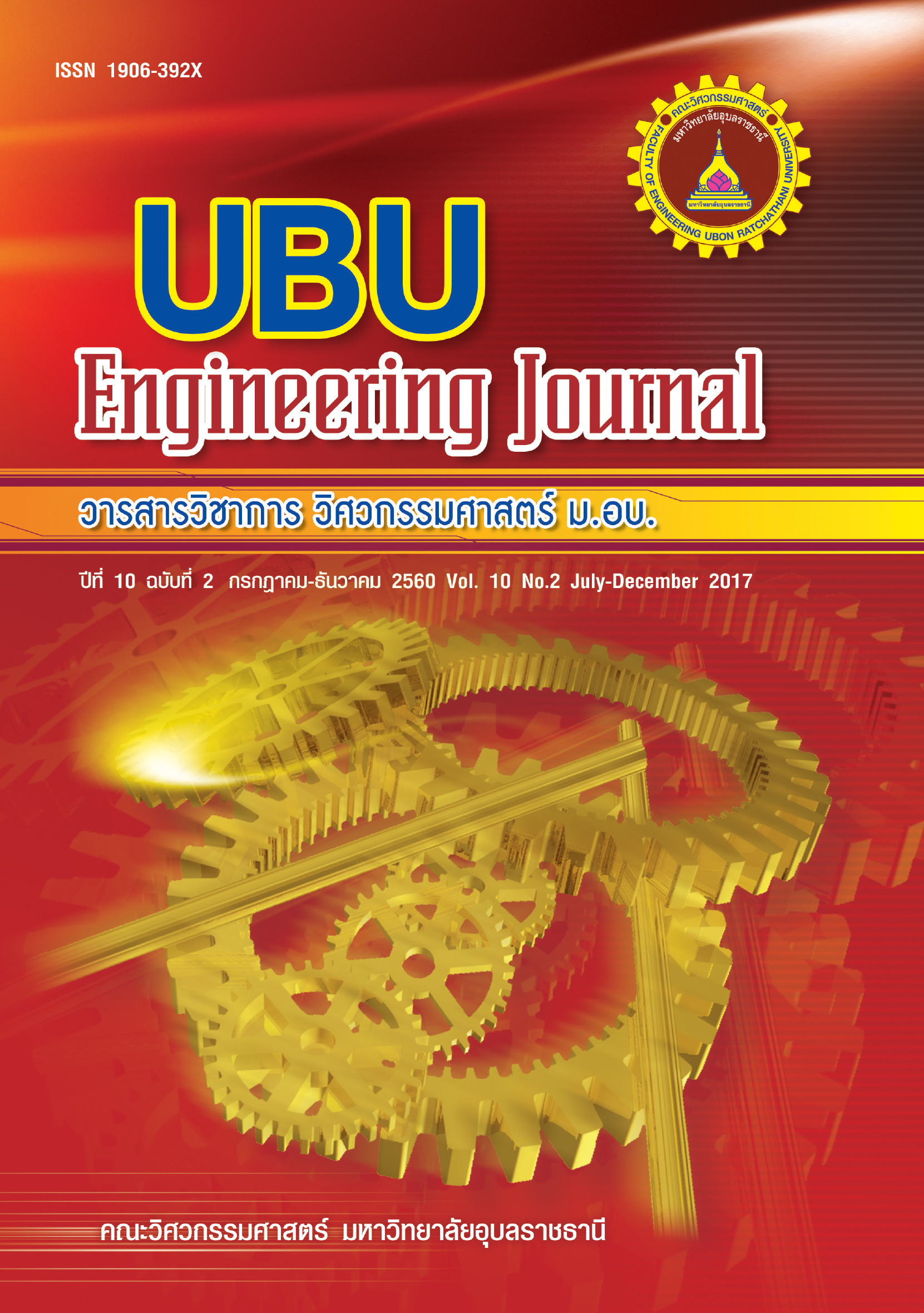การตรึงแลคเคสและเปรียบเทียบการใช้ในถังปฏิกรณ์แบบกะและแบบไหลต่อเนื่องในหอบรรจุสำหรับกำจัดพาราเซตามอล
Main Article Content
Abstract
The objective of this research was to investigate the optimum ratio for laccase immobilization using barium alginate and comparative paracetamol removal by immobilized laccase in batch reactor and continuous packed bed column reactor with three conditions, paracetamol concentrations, enzyme concentration, pH values. Crude laccase used in this work extracted from Lentinus polychous Lev. was entrapped in sodium alginate and barium chloride at concentration 5% (w/v) and 5% (w/v) respectively. Increasing in the ratio of enzyme to sodium alginate affected an increase in the percentage of immobilization yield and a decrease of enzyme leakage. The optimum ratio of laccase to sodium alginate was 1:8 (v/v). The study of paracetamol removal by immobilized laccase showed the best percentage of paracetamol removals were 78.64% and 100% in batch reactor and continuous packed bed column reactor, respectively at paracetamol concentration 1 mg/L, laccase concentration 0.216 U/g-alginate pH 7 and flow rate at 2 mL/min for continuous packed bed column reactor without the adsorb of paracetamol into entrapment material. The study indicates the potential of immobilized laccase for removal of paracetamol.
Article Details
References
[2] Stumpf M, Ternes TA, Wiken RD, Rodrigues SV, Baumann W. Polar drug residues in sewage and natural waters in the state of Rio de Janeiro, Brazil. Science of The Total Environment. 1999; 225(1–2): 135–141.
[3] Andreozzi R, Caprio V, Marotta R, Vogna D. Paracetamol oxidation from aqueous solutions by means of ozonation and H2O2/UV system. Water Research. 2003; 37(5): 993–1004.
[4] Su C-C, Chang A-T, Bellotindos LM, Lu M-C. Degradation of acetaminophen by fenton and electro-fenton processes in aerator reactor. Separation and Purification Technology. 2012; 99: 8–13.
[5] Giardina P, Faraco V, Pezzella C, Piscitelli A, Vanhulle S, Sannia G. Laccases: A never-ending story. Cellular and Molecular Life Sciences. 2010; 67(3): 369–385.
[6] Madhavi V, Lele SS. Laccase: Properties and applications. BioResources. 2009; 4(4): 1694–1717.
[7] Khlifi R, Belbahri L, Woodward S, Ellouz M, Dhouib A, Sayadi S, et al. Decolourization and detoxification of textile industry wastewater by the laccase-mediator system. Journal of Hazardous Materials. 2010; 175(1–3): 802–808.
[8] Zeng X, Cai Y, Liao X, Zeng X, Li W, Zhang D. Decolorization of synthetic dyes by crude laccase from a newly isolated Trametes trogii strain cultivated on solid agro-industrial residue. Journal of Hazardous Materials. 2011; 187(1): 517–525.
[9] Khammuang S, Sarnthima R. Laccase from spent mushroom compost of Lentinus polychrous Lev. and its potential for remazol brilliant blue R decolourisation. biotechnology. 2007; 6(3): 408–413.
[10] Bradford MM. A rapid and sensitive method for the quantitation of microgram quantities of protein utilizing the principle of protein-dye binding. Analytical Biochemistry. 1976; 72(1-2): 248–254.
[11] Nagendra P. Spectrophotometric estimation of Paracetamol in bulk and pharmaceutical formulations. E-Journal of Chemistry. 2011; 8(1): 149–152.
[12] Niladevi KN, Prema P. Immobilization of laccase from Streptomyces psammoticus and its application in phenol removal using packed bed reactor. World Journal Microbiol Biotechnol. 2008; 24: 1215–1222.
[13] Riaz A, Ul Qader SA, Anwar A, Iqbal S. Immobilization of a thermostable - amylase on Calcium alginate beads from Bacillus subtilis KIBGE-HAR. Australian Journal of Basic and Applied Sciences. 2009; 3(3): 2883–2887.
[14] Lei L, Min Z, Yan W. Immobilization of laccase by alginate–chitosan microcapsules and its use in dye decolorization. World Journal of Microbiology and Biotechnology. 2006; 23(2): 159–166.
[15] Daâssi D, Rodriguez-Couto S, Nasri M, Mechichi T. Biodegradation of textile dyes by immobilized laccase from Coriolopsis gallica into Ca-alginate beads. International Biodeterioration & Biodegradation. 2014; 90: 71–78.
[16] Azizi A, Abouseoud M, Ahmedi A. Phenol removal by soluble and alginate entrapped turnip peroxidase. Journal of Biochemical Technology. 2014; 5(4): 795–800.
[17] Ostadhadi-Dehkordi S, Tabatabaei-Sameni M, Forootanfar H, Kolahdouz S, Ghazi-Khansari M, Faramarzi MA, Degradation of some benzodiazepines by a laccase-mediated system in aqueous solution. Bioresource Technology. 2012; 125: 344–347.
[18] Maalej-Kammoun M, Zouari-Mechichi H, Belbahri L, Woodward S, Mechichi T. Malachite green decolourization and detoxification by the laccase from a newly isolated strain of Trametes sp. International Biodeterioration & Biodegradation. 2009; 63(5): 600–606.
[19] Sarnthima R, Khammuang S, Svasti J. Extracellular ligninolytic enzymes by Lentinus polychrous Lév. under solid-state fermentation of potential agro-industrial wastes and their effectiveness in decolorization of synthetic dyes. Biotechnology and Bioprocess Engineering. 2009; 14(4): 513–522.
[20] Modaressi K, Taylor KE, Bewtra JK, Biswas N. Laccase-catalyzed removal of bisphenol-A from water: protective effect of PEG on enzyme activity. Water Res. 2005; 39(18): 4309–4316.

